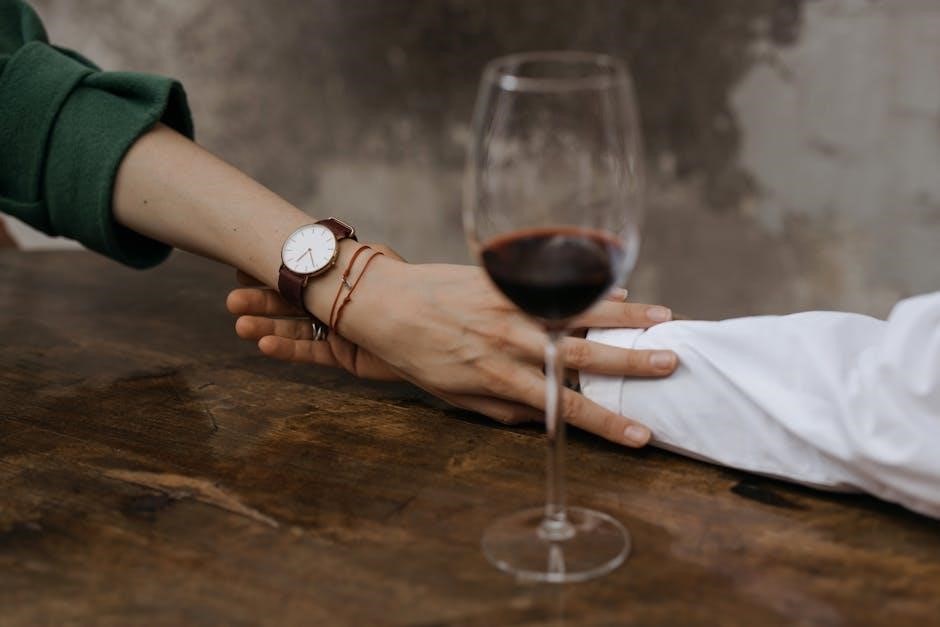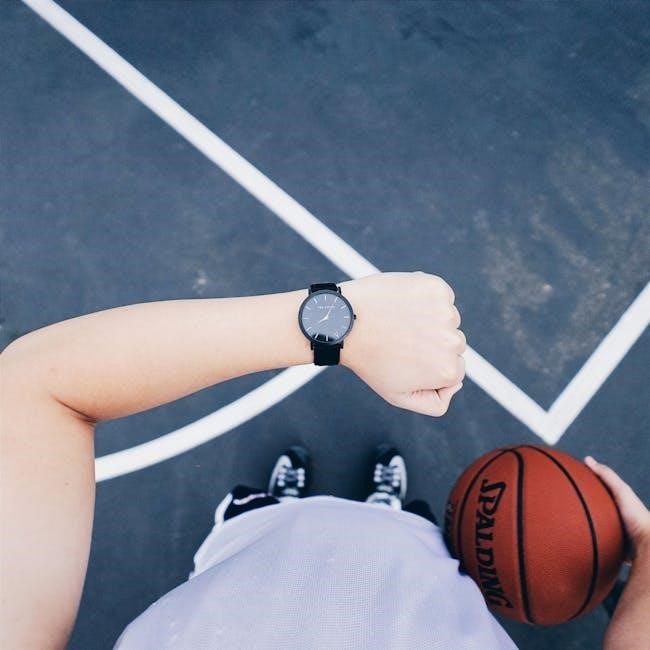
Discover the perfect watch fit with our comprehensive guide, focusing on wrist size, case diameter, and personal style. Learn how to measure accurately and choose proportional sizes for comfort and aesthetics, ensuring your timepiece complements your unique wrist dimensions.
Understanding the Importance of Proper Watch Fit
A well-fitting watch enhances both comfort and style, ensuring optimal functionality. Proper fit prevents the watch from sliding or digging into the skin, while a proportional size complements the wrist’s natural appearance. Measuring wrist circumference accurately is key, as ill-fitting watches can be uncomfortable and unflattering. The right fit ensures the watch stays secure, allowing features like heart rate monitoring to function accurately. A balanced design also enhances aesthetics, making the watch a seamless accessory for any occasion.
Evolution of Watch Sizes and Modern Trends
Watch sizes have evolved significantly over time, reflecting changing fashion and functionality. Historically, smaller watches dominated, but modern trends favor larger, statement pieces, particularly for men. Women’s watches now often blend elegance with bold designs. Smartwatches have introduced new size standards, prioritizing usability. Today, brands offer diverse options, catering to individual preferences and wrist sizes, ensuring a perfect fit for every style, from classic to oversized, while maintaining comfort and practicality in a rapidly changing market.

Understanding Wrist Size and Measurements
Accurate wrist measurements are key to finding the perfect watch fit. Use a flexible tape or printable tool to determine your wrist circumference and category, ensuring comfort and style.
How to Measure Your Wrist Circumference Accurately
To measure your wrist accurately, wrap a flexible tape measure snugly around the narrowest part of your wrist, just above the wrist bone. If you don’t have a tape measure, use a string or a printable wrist sizing tool. Mark the point where the string overlaps, then measure the length with a ruler. Ensure the measurement is neither too tight nor too loose for the best fit. This step is crucial for selecting the right watch size.
Wrist Size Categories for Watch Sizing
Wrist sizes are categorized into small, medium, and large. Small wrists typically measure 6-7 inches, medium wrists 7-8 inches, and large wrists 8 inches or more. These categories help determine the ideal watch case diameter, ensuring a balanced and comfortable fit. For example, smaller wrists suit watches with 36-40mm cases, while larger wrists can accommodate 44mm or more. Proper categorization ensures your watch complements your wrist proportions seamlessly.
The 60-75% Rule for Proportional Watch Size
The 60-75% rule ensures a watch size proportional to your wrist. Measure your wrist in millimeters and multiply by 0.6 and 0.75 to find the ideal case diameter range. For instance, a 160mm wrist suggests a 38-48mm watch. This guideline helps balance aesthetics and comfort, ensuring the watch complements your wrist without appearing too small or oversized. Adhering to this rule enhances both style and functionality, making it a reliable benchmark for selecting the perfect timepiece.

Watch Case Size and Dimensions
Watch case size and dimensions are crucial for comfort and style. Consider case diameter, thickness, and lug width relative to your wrist size for a balanced fit.
General Guidelines for Watch Case Diameter
Watch case diameter should align with your wrist size for a balanced look. Smaller wrists (under 7 inches) suit cases between 36-40mm, while larger wrists (over 7 inches) can accommodate 42-46mm. Mid-sized wrists (7-7.5 inches) are versatile, fitting 38-42mm cases. Consider personal style and watch type; sports watches may appear larger, while classic designs remain sleek. Proper fit ensures comfort and aesthetic appeal, enhancing your overall timepiece experience.
Case Thickness and Its Impact on Comfort
Case thickness significantly affects comfort, as thicker watches can feel bulky on smaller wrists. Slim cases (8-10mm) are ideal for delicate wrists, offering a sleek, unobtrusive fit. Thicker cases (12mm+) suit larger wrists or those who prefer bold styles. Balancing thickness with wrist size ensures optimal comfort and aesthetics, making your watch a seamless accessory for daily wear or special occasions without compromising on style or functionality.

Band and Strap Considerations
Straps and bands play a crucial role in fit and style. Materials like leather, metal, or silicone offer varying comfort levels and aesthetic appeal, ensuring a personalized fit for any wrist size or lifestyle, while adjustable and fixed bands cater to different preferences and needs, enhancing both functionality and visual harmony with the watch case.
Material Options and Their Fit Implications
Watch bands come in various materials, each offering unique fit and comfort benefits. Leather straps provide a classic look and can be padded for extra comfort, while metal bands, like bracelets, offer durability and adjustable precision. Silicone and rubber straps are flexible and breathable, ideal for sports or everyday wear. Fabric straps, such as NATO or canvas, add a lightweight, stylish touch. Choosing the right material ensures a comfortable fit and complements your lifestyle, whether formal or active.
Adjustable vs. Fixed Bands: Which is Better?
Adjustable bands offer versatility, fitting various wrist sizes with a customizable fit, ensuring comfort and security. Fixed bands provide a sleek, tailored look but may require precise sizing. Choose adjustable for flexibility and ease, or fixed for a polished, permanent style that suits your wrist perfectly, balancing practicality and aesthetics based on your lifestyle and preferences.

Style Preferences and Watch Size
Your watch size should reflect your personal style, whether classic elegance or modern boldness. Consider proportions, wrist size, and design trends to select a timepiece that enhances your look and matches your unique aesthetic preferences seamlessly.
Classic vs. Oversized Watches: Choosing the Right Style
Classic watches, typically between 36mm to 42mm, offer timeless elegance and versatility, suiting smaller wrists and formal occasions. Oversized watches, often 44mm or larger, make a bold statement, ideal for larger wrists and trend-focused styles. Consider your wrist size, personal taste, and lifestyle to choose between these options. The right style enhances your look, ensuring comfort and confidence. Balance proportions for a seamless fit that complements your unique aesthetic and preferences.
Gender-Specific Watch Sizes and Trends
Watch sizes often align with traditional gender norms, though modern trends blur these lines. Men’s watches typically range from 40mm to 46mm, while women’s watches are usually 28mm to 36mm. However, unisex styles are gaining popularity. Average wrist sizes for men are around 18.42cm, and for women, between 15cm-16cm. Case diameters and band widths are tailored to these averages, though personal style and comfort now drive many choices, making gender-specific sizing less rigid in contemporary fashion.
Watch Size Guide for Specific Wrist Types
Discover tailored recommendations for small, medium, and large wrists. Learn ideal case diameters and strap styles to ensure comfort and style, based on your unique wrist size.
Best Watch Sizes for Small Wrists
For small wrists, watches with case diameters between 32-38mm are ideal, ensuring a proportional fit. Thinner cases and narrower lug widths (around 20mm) enhance comfort. Opt for lightweight materials like leather or mesh straps, which provide a snug, breathable fit. Avoid oversized designs, as they may overwhelm the wrist. Instead, choose minimalist or classic styles that complement the wrist’s delicate structure. This sizing ensures a balanced, elegant look while maintaining functionality and comfort for smaller wrists.
Best Watch Sizes for Large Wrists
Large wrists benefit from watches with case diameters ranging from 44-46mm, offering a proportional and balanced appearance. Thicker cases and wider lug widths (around 22-24mm) provide a sturdy fit. Opt for robust materials like metal or rubber straps, which ensure durability and comfort. Avoid overly small designs, as they may look out of place. Instead, choose bold or oversized styles that complement the wrist’s larger structure. This sizing ensures a confident, stylish look while maintaining functionality for larger wrists.

Luxury and Designer Watch Considerations
Luxury watches often feature case sizes between 38-42mm, paired with premium materials like leather or metal straps. These dimensions ensure a sophisticated and proportional fit on most wrists, aligning with high-end design aesthetics.
Case Size Recommendations for Luxury Brands
Luxury watches typically feature case sizes between 38mm to 42mm, offering a classic and elegant fit. These dimensions are proportionate for most wrists, ensuring comfort and style. High-end brands often prioritize materials like leather or metal straps, enhancing both aesthetics and durability. For smaller wrists, 36mm to 38mm cases are ideal, while larger wrists may prefer 44mm or more. Ultimately, luxury watches balance sophistication with practicality, making them timeless investments for any wrist size or personal taste.
How to Match Your Watch Size with Your Lifestyle
Your watch size should align with your daily activities and personal style. For active lifestyles, opt for durable, water-resistant models with secure straps. Formal events call for sleek, minimalist designs with smaller case sizes. If you work outdoors, larger, robust watches with clear dials are practical. Consider smartwatches for fitness tracking or luxury timepieces for professional settings. The right watch size enhances functionality and complements your unique lifestyle, ensuring it fits seamlessly into your routine and preferences.

Smartwatch Size Guide
Smartwatches vary in size to suit diverse needs. Popular models range from 38mm to 46mm in diameter, offering options for smaller and larger wrists. Choose a size that balances functionality and comfort, ensuring the display is easy to read without feeling bulky. Adjustable bands provide a secure fit, while interchangeable straps allow personalization. Whether for fitness tracking or everyday use, the right smartwatch size enhances your experience and complements your wrist perfectly.
Popular Smartwatch Models and Their Sizes
Popular smartwatches like the Apple Watch Series 7 and Samsung Galaxy Watch 4 offer diverse size options. Apple Watches range from 38mm to 44mm, catering to both small and large wrists. Samsung’s Galaxy Watch 4 is available in 40mm and 46mm, providing a comfortable fit for various wrist sizes. These models ensure proportional sizing, with adjustable bands for versatility. Whether you prefer a sleek, compact design or a larger, bold statement, these smartwatches deliver functionality and style tailored to your wrist size.
How to Choose the Right Smartwatch Band
Selecting the right smartwatch band ensures comfort and style. Measure your wrist to match the band’s size, as most smartwatches have specific width requirements. For Apple Watches, bands are designed for 38mm to 44mm cases, while Samsung’s Galaxy Watch bands fit 20mm or 22mm lugs. Consider materials like silicone, leather, or metal, and choose adjustable or fixed options based on your lifestyle. Ensure the band is breathable and durable for all-day wear, enhancing both functionality and personal style seamlessly.

Cultural and Personal Factors in Watch Sizing
Cultural preferences and personal style significantly influence watch size choices. Some cultures favor larger, bold watches, while others prefer understated designs. Individual style, lifestyle, and wrist proportions guide these decisions, ensuring the watch complements both aesthetic and functional needs uniquely.
How Cultural Preferences Influence Watch Size
Cultural preferences play a significant role in determining watch size trends. In some regions, larger watches symbolize status and sophistication, while in others, minimalist designs are favored. For instance, European styles often lean toward classic, mid-sized timepieces, whereas Middle Eastern markets frequently embrace bold, oversized models. These cultural influences not only shape design preferences but also affect the perceived appropriateness of watch sizes for different occasions, reflecting local tastes and lifestyle expectations.
Personal Style and Watch Size Compatibility
Your personal style significantly influences the ideal watch size. For a sleek, minimalist look, smaller cases are often preferred, while bold fashion statements may call for larger, oversized designs. Consider your wardrobe and lifestyle—slender wrists pair well with delicate watches, while athletic builds can accommodate chunkier models. Ultimately, the watch should harmonize with your aesthetic, ensuring both comfort and visual appeal that aligns with your unique taste and daily activities.

Final Tips for Choosing the Perfect Watch Size
Consider your lifestyle, personal style, and wrist measurements to ensure a comfortable fit. Try different sizes if possible, and use the golden ratio for proportional guidance to find your ideal watch size.
Using the Golden Ratio for Watch Size Selection
To apply the Golden Ratio, divide your wrist size in millimeters by 1.618 to determine the ideal watch case diameter. For example, a 160mm wrist suggests a 40mm watch. This method helps achieve a balanced, visually pleasing proportion between the watch and wrist. While rules are guidelines, feel free to experiment with sizes to find what looks and feels best personally, ensuring both style and comfort.
Practical Advice for First-Time Watch Buyers
For first-time buyers, start by measuring your wrist accurately to determine the ideal case size. Consider your lifestyle—active users may prefer durable materials, while formal settings call for sleek designs. Try on watches if possible or use online size guides. Balance style preferences with comfort, ensuring the watch isn’t too tight or loose. Prioritize quality and functionality, and don’t hesitate to seek advice from experts or reviews to make an informed decision that suits your needs and budget.
Choosing the right watch size ensures comfort and style. Consider wrist size, case diameter, and personal preferences for the perfect fit. Find your ideal timepiece!
Summarizing Key Takeaways for Watch Size Selection
Accurate wrist measurement is crucial for a perfect fit. Use the 60-75% rule to ensure proportional sizing. Consider case thickness for comfort and style. Material and band type impact fit, while personal style dictates design choice. Experiment with sizes and styles to find your ideal match, balancing aesthetics and functionality for a timepiece that complements your unique wrist and lifestyle.
Encouraging Readers to Experiment and Find Their Perfect Fit
Dont be afraid to try different watch sizes and styles to discover what works best for you. Every wrist is unique, and personal preference plays a significant role in choosing the ideal timepiece. Experiment with various case diameters, band materials, and designs to find a balance between comfort and aesthetics. Remember, the right fit enhances both functionality and style, making your watch a seamless extension of your personality and daily life.